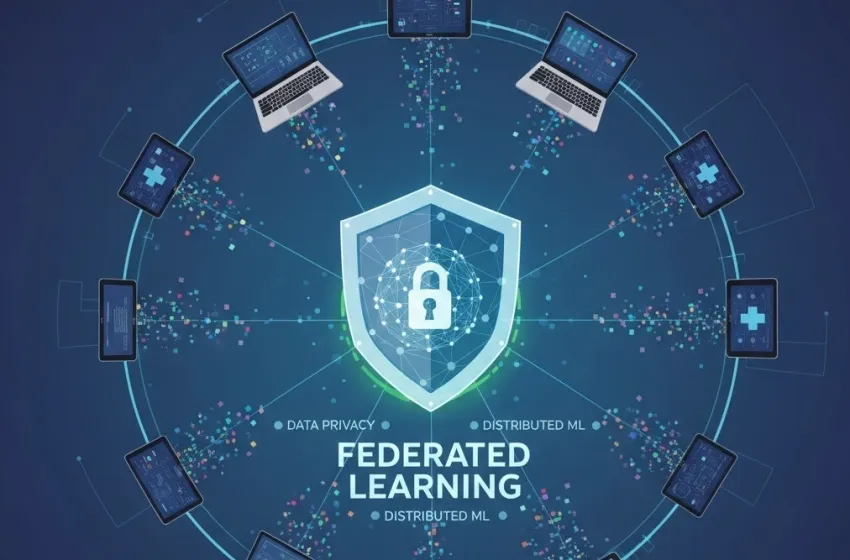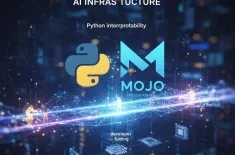Learn how secure aggregation and differential privacy protect sensitive user data privacy in the age of AI.
The modern landscape of Artificial Intelligence (AI) and Machine Learning (ML) is defined by a paradox: the models that provide the most personalized, accurate, and impactful services require vast amounts of data, yet the public and regulatory bodies demand increasingly stringent protection for that same data. This conflict—the push for data utility versus the imperative of data privacy—is one of the defining challenges of the 21st century.
Federated Learning (FL) emerges as the groundbreaking answer to this dilemma. It is a revolutionary distributed ML paradigm that allows multiple entities to collaboratively train a shared, robust model while keeping all their sensitive training data decentralized and local. FL transforms the traditional model of data centralisation, offering a path to powerful AI development that inherently respects data privacy laws and user trust.
The Core Concept: Decentralizing Model Training
At its heart, Federated Learning is a machine learning technique where models are trained locally on user devices (or edge nodes) and only aggregated model updates are shared, preserving raw data privacy.
This architecture fundamentally flips the traditional centralized ML model:
- Traditional ML: Raw data from every user is collected, uploaded to a central server/cloud, and then used to train a single model. This creates a massive, centralized honeypot of sensitive data, making it a prime target for security breaches and incurring significant regulatory compliance costs.
- Federated Learning (FL): The model, not the data, is sent to the devices. A central orchestrating server sends the current global model to a select group of clients (e.g., smartphones, hospitals, or IoT devices). These clients perform on-device training using their local, proprietary data. Once training is complete, the clients send only the small, encrypted model updates (gradients or weights) back to the server. The raw data never leaves the device.
This process is typically executed in iterative "rounds" and coordinated by an algorithm like Federated Averaging (FedAvg), which calculates a weighted average of all received client updates to form a new, improved global model. This new model is then redistributed to the clients for the next round of local training.
Federated Learning Architecture and Its Benefits
The FL framework is broadly categorized into two main types, addressing different industry needs:
Cross-Device FL (The Edge)
This is the most common form, involving a massive number of mobile devices or IoT gadgets (e.g., training next-word prediction keyboards on millions of smartphones).
- Characteristics: High number of clients, unreliable network connectivity, and low computation/data capacity per device.
- Goal: To learn from a diverse, globally distributed user base.
Cross-Silo FL (The Enterprise)
This involves a smaller number of large, resource-rich organizations (silos), such as hospitals, banks, or governmental agencies.
- Characteristics: Low number of clients, stable network connectivity, and vast, sensitive datasets held securely within each institution.
- Goal: To collaboratively build powerful models using highly sensitive data (like medical records or financial transactions) that cannot, under any circumstances, be shared or centralized due to legal or ethical mandates.
| Key Benefit | Description |
|---|---|
| Privacy by Design | Raw data remains on the local device, minimizing the attack surface and significantly reducing the risk of a catastrophic data breach. |
| Regulatory Compliance | Helps organizations comply with strict regulations like GDPR, CCPA, and HIPAA by ensuring data residency and minimizing the processing of personal data. |
| Access to Diverse Data | Enables the training of more robust and generalizable models by learning from real-world, non-IID (non-independently and identically distributed) data that is otherwise siloed. |
| Reduced Communication | Sending compact model updates is often more efficient than constantly streaming large volumes of raw data to a central cloud. |
The Pillars of Privacy: Secure Aggregation and Differential Privacy
While FL is privacy-preserving by decentralizing the data, model updates (gradients and weights) can still be vulnerable to sophisticated inference attacks. Researchers have demonstrated that a malicious central server can sometimes reverse-engineer a client's training data by analyzing the shared gradient updates. To counter this, FL relies on two cryptographic and mathematical techniques that are central to achieving genuine, robust data privacy.
Secure Aggregation (SA)
Secure Aggregation is a cryptographic protocol designed to ensure that the central server can only compute the aggregate (sum or average) of the model updates across a group of clients, without being able to decrypt or inspect any individual client's contribution.
- Mechanism: It typically employs techniques like Secure Multi-Party Computation (SMC) or homomorphic encryption.
- Goal: The server receives $G_1 G_2 \dots G_N$, where $G_i$ is the model update from client $i$. Critically, the server cannot know the value of any individual $G_i$. It only sees the sum.
- Impact: This protects the individual client’s model update from the central server and prevents the server from isolating a specific user’s data contribution. If a client update is corrupted or malicious, the server cannot identify the culprit without the aggregation failing, but it ensures that the update itself is hidden from the server unless the required number of participants successfully collaborate in the aggregation.
Differential Privacy (DP)
Even with secure aggregation, an adversary (including the central server) could potentially learn information about a single user's data by observing the global model's behaviour across multiple training rounds. Differential Privacy (DP) is a rigorous, mathematically quantifiable framework used to prevent this by introducing controlled randomness.
- Definition: DP guarantees that the output of an algorithm is almost equally likely whether or not any single individual’s data is included in the input dataset. In simpler terms, an observer should not be able to tell if a specific individual participated in the training by looking at the final model.
- Mechanism (Noise Addition): In the context of FL, DP is achieved by injecting calibrated random noise, often Gaussian noise, to the model updates (gradients) before they are sent to the central server. $$ \text{Update}_{\text{DP}} = \text{Update}_{\text{original}} \text{Noise}(\epsilon) $$ The level of privacy is quantified by a parameter, $\epsilon$ (epsilon), known as the privacy budget. A smaller $\epsilon$ means stronger privacy protection but requires more noise, which can reduce the model's accuracy (utility). Conversely, a larger $\epsilon$ allows for higher accuracy but weaker privacy guarantees.
- Types in FL:
- Local DP: Noise is added by the client to their update before it leaves the device. This offers the strongest per-user privacy guarantee, as the server never sees the exact update.
- Central DP: Noise is added by the central server to the aggregated update before the new global model is distributed. This is generally more effective for utility, as the noise averages out over many users, but it requires the server to be a "trusted" entity.
The combination of Secure Aggregation (hiding the individual contribution) and Differential Privacy (masking the presence of any single data point) creates a powerful, multi-layered defense system for robust data privacy in the distributed ML environment.
Challenges and Trade-offs in On-Device Training
While Federated Learning offers immense potential, particularly with on-device training, its implementation is fraught with unique technical challenges that require sophisticated engineering solutions.
Data Heterogeneity (Non-IID Data)
In the real world, user data is inherently non-uniform. A smartphone user in one region may have a vastly different usage pattern or language than a user in another. This leads to Non-Independent and Identically Distributed (Non-IID) data across clients. If the local models are trained on highly skewed data, the global aggregated model can suffer from model drift and fail to generalize effectively across all users.
Communication and Infrastructure Constraints
The effectiveness of FL relies on clients frequently sending updates. In the cross-device setting, this is challenging because:
- Network Volatility: Mobile devices have unstable, bandwidth-limited connections.
- Energy Consumption: Local training is computationally intensive and can quickly drain a device’s battery.
- Client Selection: The central server must intelligently schedule which clients participate in which round, often selecting only clients that are charging, on Wi-Fi, and have a good amount of training data.
The Privacy-Utility Trade-off
This is the most critical balance in FL, especially when deploying differential privacy. Every privacy-enhancing technique (PET) introduces some level of randomness or loss of information, which inevitably impacts the final model’s performance. The system designer must carefully tune parameters (like the DP budget $\epsilon$) to achieve the strongest possible data privacy guarantee while retaining acceptable model accuracy (utility). This balance is highly application-specific, where a small accuracy loss in a keyboard predictor is acceptable, but a tiny loss in a medical diagnostic model is not.
Conclusion: A Responsible Path to Advanced AI
Federated Learning is not merely a technical novelty; it is a foundational shift in how the industry approaches data and model development. By leveraging on-device training and a distributed ML architecture, FL ensures that the power of AI can be unlocked without compromising the fundamental right to data privacy. The integration of advanced mechanisms like secure aggregation and the mathematical guarantees of differential privacy fortify the system against sophisticated attacks, moving beyond simple decentralization to true, measurable privacy protection.
While challenges remain—particularly the trade-off between privacy and utility and the complexities of handling non-IID data—the relentless pursuit of responsible AI is driving innovation in this field. As regulators tighten their grip on data handling and user demand for privacy grows, Federated Learning stands as the essential blueprint for the next generation of intelligent, ethical, and legally compliant AI systems. It offers a future where personalized experiences are delivered not at the expense of user data, but because of its protected, collaborative use.



































